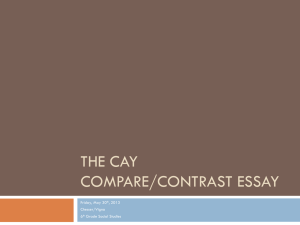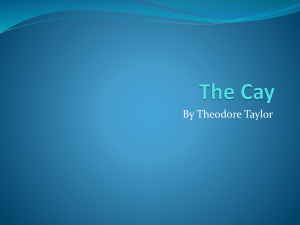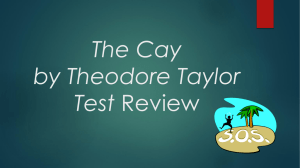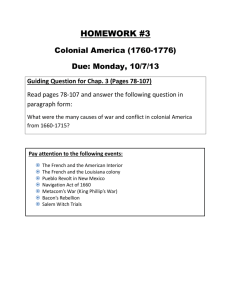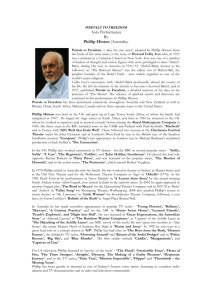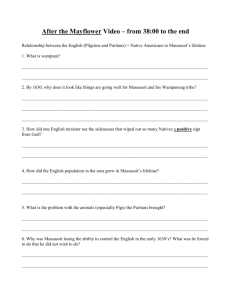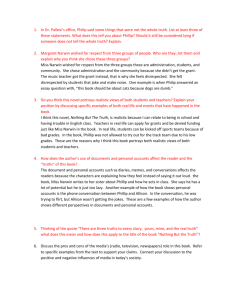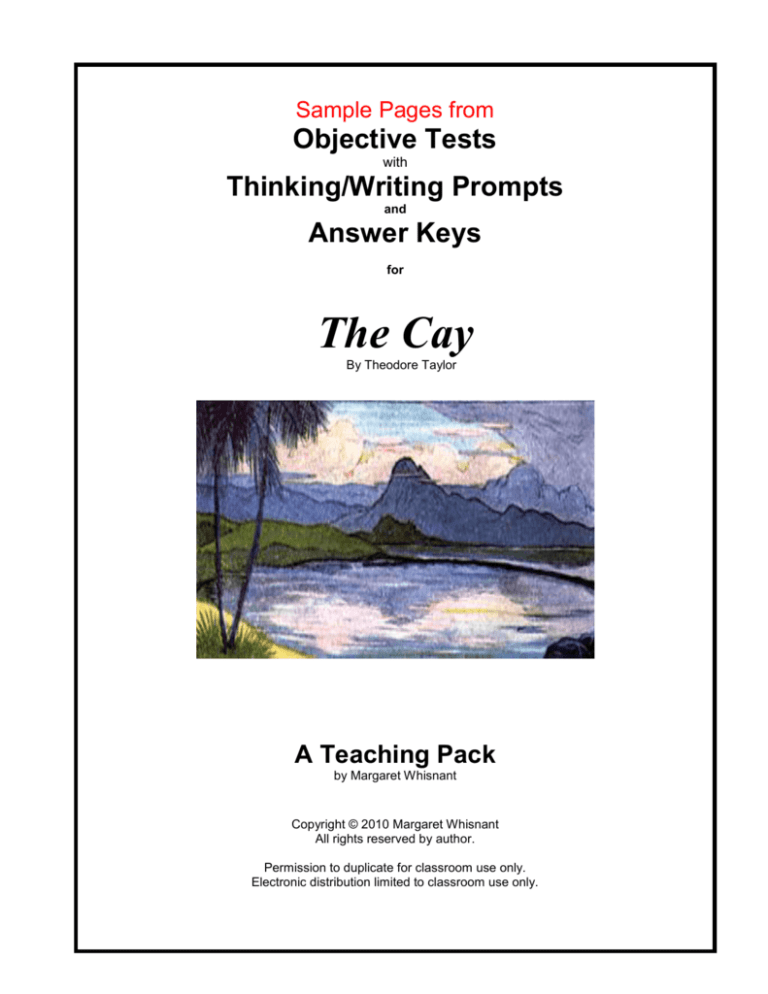
Sample Pages from
Objective Tests
with
Thinking/Writing Prompts
and
Answer Keys
for
The Cay
By Theodore Taylor
A Teaching Pack
by Margaret Whisnant
Copyright © 2010 Margaret Whisnant
All rights reserved by author.
Permission to duplicate for classroom use only.
Electronic distribution limited to classroom use only.
Copyright © 2008 Margaret Whisnant
Table of Contents
Chapter Tests
Chapter One . . . . . . . . . . . . . . . . . . . . . . . . . . . . . . . . . . . . . . . . . . . . . . . . . . . Pages 1-2
Chapter Two . . . . . . . . . . . . . . . . . . . . . . . . . . . . . . . . . . . . . . . . . . . . . . . . . . . Pages 3-4
Chapter Three . . . . . . . . . . . . . . . . . . . . . . . . . . . . . . . . . . . . . . . . . . . . . . . . . . Pages 5-6
Chapter Four. . . . . . . . . . . . . . . . . . . . . . . . . . . . . . . . . . . . . . . . . . . . . . . . . . . Pages 7-8
Chapter Five—Chapter Six. . . . . . . . . . . . . . . . . . . . . . . . . . . . . . . . . . . . . . . . Pages 9-10
Chapter Seven—Chapter Eight . . . . . . . . . . . . . . . . . . . . . . . . . . . . . . . . . . . . Pages 11-12
Chapter Nine-Chapter Ten . . . . . . . . . . . . . . . . . . . . . . . . . . . . . . . . . . . . . . . . Pages 13-14
Chapter Eleven . . . . . . . . . . . . . . . . . . . . . . . . . . . . . . . . . . . . . . . . . . . . . . . . . Pages 15-16
Chapter Twelve—Chapter Thirteen . . . . . . . . . . . . . . . . . . . . . . . . . . . . . . . . . Pages 17-18
Chapter Fourteen—Chapter Fifteen . . . . . . . . . . . . . . . . . . . . . . . . . . . . . . . . . Pages 19-20
Chapter Sixteen—Chapter Seventeen . . . . . . . . . . . . . . . . . . . . . . . . . . . . . . . Pages 21-22
Chapter Eighteen—Chapter Nineteen . . . . . . . . . . . . . . . . . . . . . . . . . . . . . . . Pages 23-24
Whole Book Test . . . . . . . . . . . . . . . . . . . . . . . . . . . . . . . . . . . . . . . . . . . . Pages 25-28
Keys . . . . . . . . . . . . . . . . . . . . . . . . . . . . . . . . . . . . . . . . . . . . . . . . . . . . . . . . Pages 29-30
Thinking/Writing Prompts . . . . . . . . . . . . . . . . . . . . . . . . . . . . . . . . . . . . Pages 31-37
About Your Teaching Pack . . . . . . . . . . . . . . . . . . . . . . . . . . . . . . . . . . . Pages 38-40
Copyright © 2007 Margaret Whisnant
2
THE CAY
By Theodore Taylor
Chapter One
Pages 9-17
Write either True or False in the blank before each statement.
___________1. Phillip lived on one of the Dutch islands just off the coast of Venezuela.
___________2. The purpose of the German submarine attack was to destroy an American
military base on one of the main islands.
___________3. It was February, 1942, when the Germans attacked.
___________4. The possibility of a German attack on his island terrified Phillip.
___________5. Since there was no school because of the Germans, Phillip’s mother gave him
permission to go down to the old fort and watch for submarines.
___________6. Phillip found the fort, which was usually like something out of a storybook, filled
with soldiers, rifles, and machine guns.
___________7. The German attack on the other islands had not caused much damage.
___________8. Holland had been captured by the Nazis, but Henrik still believed the Dutch
navy would come to the islands.
___________9. An army officer ordered Phillip and Henrik to leave the Queen Emma
bridge because they could easily be killed by a torpedo.
Copyright © 2007 Margaret Whisnant
1
THE CAY
By Theodore Taylor
Chapter Two
Pages 19-28
Write either Yes or No in the blank before each question.
______1. Were there blackout curtains on Phillip’s house because the governor had ordered that
not a light could shine anywhere on the island?
______2. Did Phillip take a hatchet from the tool house to use against the Germans if they
attacked during the night?
______3. Did Phillip’s father suggest that Phillip and his mother take a boat back to Norfolk and
wait until the danger was over?
______4. Was Phillip’s mother afraid to fly?
______5. Did the thought of leaving the island make Phillip happy?
______6. Was the refinery on Curacao able to ship its precious gas and oil to England and Africa
in spite of the German threat?
______7. Did the lack of rain make it necessary for fresh water to be shipped to the island?
______8. Without the movement of ships, were the people of Curacao helpless?
______9. Did Phillip’s mother accept their situation without complaining?
_____10. Was the British tanker Empire Tern equipped with machine guns and loaded with
gasoline when it steamed out of the harbor?
_____11. As Phillip and many others watched, did the Empire Tern vanish in a wall of red flames?
_____12. After the experience with the Empire Tern, was Phillip still excited about the war?
Copyright © 2007 Margaret Whisnant
2
THE CAY
By Theodore Taylor
Chapter Three
Pages 29-39
Write the letter of the correct answer in the blank before each question.
______1. Two days after leaving Panama, in the early morning of April 6, 1942, the Hato was
(A) torn apart in a storm, (B) torpedoed, (C) accidentally bombed.
______2. As they prepared to leave the cabin, Phillip’s mother was (A) in a panic, (B) crying
quietly, (C) very calm.
______3. The lifeboat Phillip and his mother were in spilled its passengers when (A) the Hato
lurched forward, (B) it broke in half, (C) it became tangled in the anchor line.
______4. In the water, Phillip (A) could so longer see his mother, (B) fainted, (C) was hit on the
head from above.
______5. Which of the following was not true of the very old Negro Phillip found sitting on the raft
with him? (A) Phillip had never seen him before. (B) His head was a mass of wiry gray
hair. (C) Phillip thought he was ugly.
______6. From the old man’s appearance, Phillip knew he was (A) American, (B) West Indian,
(C) Cuban.
______7. The Negro believed Phillip’s mother (A) was safe and sound on a raft or a boat,
(B) could have drowned, (C) wasn’t far away.
______8. The old man thought their location was somewhere (A) near Panama, (B) around the
cays, (C) slightly south of the Yucatan.
______9. Which of the following was not a reason Phillip burst into tears? (A) There was nothing
but an empty sea around him. (B) He had sharp pains in his head. (C) He was
frightened by the big black man.
_____10. The cat’s name was (A) Oil, (B) Cook, (C) Stew.
Copyright © 2007 Margaret Whisnant
3
THE CAY
By Theodore Taylor
Chapter Five: Pages 49-55
Chapter Six: Pages 55-58
Timothy
sharks
Stew Cat
Phillip
the sea
a “motah”
smoke
birds
his father
palm
the small island
the airplane
a torch
the raft
From the list above, choose the word, name, or phrase that fits each of the clues below and write it in
the blank. All answers will be used at least once. Some answers will be used more than once.
_____________________1. Timothy warned Phillip about these when he reached over the edge
of the raft to touch the water.
_____________________2. Phillip thought it might be even worse than the raft.
_____________________3. He thought it would have been awful to have awaken on the raft and
not know what his companions looked like.
_____________________4. It did not come to their rescue as Timothy and Phillip had hoped.
_____________________5. This was the sound that Timothy heard toward noon on the third day.
_____________________6. Timothy saved Phillip from these.
_____________________7. He went into an angry rage because of the dangerous brush with the
sharks.
_____________________8. It became so calm, the raft didn’t seem to be drifting.
_____________________9. He was happy they found the island because he wanted to be off the
sea.
____________________10. He shouted when he saw the island.
Copyright © 2007 Margaret Whisnant
4
THE CAY
By Theodore Taylor
WHOLE BOOK TEST
Write the letter of the correct answer in the blank before each question.
______1. Phillip and his family lived on the island of Curacao located just off the coast of
(A) Panama, (B) California, (C) Venezuela.
______2. This story took place from February to August in the year (A) 1939, (B) 1942, (C) 1948
.
______3. German submarines were prowling the islands because they wanted to destroy (A) the
American military bases located there, (B) the oil and gas refineries as well as the
tankers carrying fuel from the islands, (C) the supply ships transporting food and fabrics
to England.
______4. Phillip’s family was from (A) Virginia, (B) New York, (C) Miami.
______5. Phillip’s father had been hired by Royal Dutch Shell because he was an expert in
(A) locating new oil wells, (B) tanker design and construction, (C) refineries and gasoline
production.
______6. Henrik was Phillip’s (A) cousin, (B) next-door neighbor, (C) best friend.
______7. Because she thought they weren’t safe on the island, Phillip’s mother (A) wanted to
move to the army base, (B) wouldn’t allow Phillip to leave the house, (C) insisted on
taking Phillip back to Norfolk.
______8. Phillip’s mother (A) didn’t like black people, (B) taught him to respect people of all skin
colors, (C) wouldn’t allow him to go near the black people who worked on the docks.
______9. The freighter that Phillip and his mother were aboard sank when (A) the gasoline it was
carrying exploded, (B) it was hit by a German Torpedo, (C) it was battered in a furious
storm.
_____10. The freighter sank two days after leaving Panama on its way to (A) Miami, (B) Cuba,
(C) Venezuela.
Copyright © 2007 Margaret Whisnant
5
THE CAY
By Theodore Taylor
Something to Think About. . .
Something to Write About. . .
1.
You may have heard someone talk about a person who is “in denial” about a situation.
From the psychological standpoint, the definition of such denial is an unconscious defense
mechanism characterized by refusal to acknowledge painful realities, thoughts, or feelings.
Explain how each of the following quotes from the story is an example of Phillip’s denial
about the danger he and his family were in:
I was not frightened, just terribly excited. War was something I’d heard a lot about,
but had never seen.
I couldn’t imagine that a shell from an enemy submarine would pick me out from
all the buildings, or hit me if I was standing on the famous pontoon bridge. . .
“We just wanted to see the submarines,” I said.
I put (the hatchet) under the couch. It was the only thing I could think of to use for
fighting the Germans.
Name a dangerous place or thing in today’s world that can lead people into a state of denial.
What are some of the danger signals? Why do you suppose people ignore them?
2.
How do you know that Phillip’s mother was homesick?
Do you think Phillip’s father made the right decision in bringing his family to a strange place
to help with the war effort? Why or why not? Explain how his choice had been both beneficial
and destructive for the family.
How would you characterize his mother’s decision to take him by ship back to Norfolk? Was
it wise or selfish? Explain.
Copyright © 2007 Margaret Whisnant
6
Something to Think About. . .
Something to Write About . . .
The Cay
By Theodore Taylor
3.
When he said good-by to Henrik and the other boys, Phillip told them he planned to visit his
grandparents, and he would be gone just a short time. But he had the feeling that it might be
a very long time before (he) saw Chraçao and his father again.
Would you say that Phillip had a premonition about the journey he was about to take? What
information did he have that would have caused him to feel the way he did about leaving?
In your opinion, do people have the ability to sometimes know ahead of time when a decision
will go wrong? Is it a matter of an unexplained knowing or is it usually based on important
clues? Explain your position by giving at least one example from your experiences.
4.
Floating on the raft with Phillip, Timothy said they had rare good luck.
Why did Timothy say they were lucky?
How did the situation look different from Timothy’s point of view?
What is your opinion? Were the two people and the cat lucky or were they unlucky? Explain
your answer.
5.
Find four clues from the time that Timothy, Phillip, and Stew Cat were on the raft to prove
that Timothy was a kind-hearted, considerate, and wise man. Do you think Philip saw and
understood these clues? How do you know?
6.
On the raft, what did Timothy do that seemed to prove Philip’s mother was right in saying
that black people were “different?”
How did Timothy’s “difference” lead him to call Phillip “young bahss?”
From your point of view, how was Timothy truly different from Phillip when it came to
knowing how to survive? How was his attitude toward responsibility and blame also different?
Copyright © 2007 Margaret Whisnant
7
About Your Teaching Pack
Objective Tests
The objective tests have multiple functions. In addition to their obvious application, they also serve as
tools that can improve comprehension skills by providing practice in understanding plot structure and
recognizing important story elements.
Rationale:
Focus on the Plot. . .
Whether they are aware of their ability or not, all good readers sense the rhythm of the connected
events that compose the plot of a novel, and consequently comprehend the story. They are in tune with
cause and effect, behavior and consequence, sequence—the heartbeat of the narrative.
This “plot rhythm” forms the framework for the objective tests. The chain of events that tell the story have
been pulled from the novel and reformatted into a series of sequential questions, none of which require
interpretation. They are intended to draw student attention to the fact that something happened, not to
what the incident means. That comes later.
In addition to their testing function, teachers may use the pages to strengthen their students’ ability to
Summarize: With only the questions as a guide, have students write a summary of the chapter. For a set of
ten questions, limit the number of sentences they may write to seven or fewer. When they work with twenty
or more questions, allow no more than twelve sentences.
Report the News: Ask your students to write a newspaper article based on the events identified in a set of
questions and the who, what, when, where, why elements. Some information needed to complete this
assignment may be located in previous chapters.
Twist the Plot: Choose one or two questions from each chapter and change its answer—true to false, no to
yes, etc.—to demonstrate how changing a single (or several) events would (or would not) change the story.
This process can be used to help students become proficient in distinguishing major plot movers from minor
story details.
The Characters. . .
Too often, when they are asked to describe a story character’s personality, the only answer many
students can muster is “nice.” This portion of the Novel Teaching Pack, coupled with related activities from
Something to Think About, Something to Write About, is a well of opportunities for those teachers who
wish to eradicate “nice” from their students’ vocabularies!
Questions that identify a character’s personality and/or motivation are purposely and carefully included
with the plot movers. Again, the questions do not require interpretation. They simply establish that
someone did or said something—knowledge that is invaluable when character analysis is required.
Implied Meaning and Story Clues. . .
The objective tests include items that establish the existence of story components carrying implied
meaning. Story clues that tantalize the reader with hints of future events also appear as question. At this
point in the novel study, as before, interpretation is not the goal. Awareness of the facts is the target.
Developing/Improving Listening Skills. . .
Listening skills are rightfully included on every list of state competency requirements. Rather than always
requiring students to answer test questions on a printed page, why not surprise them occasionally by doing
the test orally and meeting competency goals at the same time?
Discussion Guide Capability. . .
The objective tests are helpful discussion guides. Use individual items on these pages to draw student
attention to sequence, cause and effect, story clues (foreshadowing), character traits, recognizing and
interpreting implied meanings, etc. These “thinking out loud” sessions are an important building block for
the next learning phase.
Copyright © 2008 Margaret Whisnant
Something to Think About. . .
Something to Write About. . .
In this section, students pack up what they already know about the novel and go exploring into its every
nook and cranny. Some activities require the simplest interpretation or application, while others will challenge
the most proficient thinkers.
Rationale:
Guidelines. . .
Most of the items in this section are based on the skills presented in the Taxonomy of Educational
Objectives (Bloom’s Taxonomy). There are two reasons for this choice. First, it mirrors the Novel
Teaching Pack’s primary purpose of building a variety of sophisticated thinking skills on a foundation of basic
knowledge. Second, in following the taxonomy guidelines, activities that correlate with many state
educational standards emerge automatically.
Levels of Difficulty. . .
A broad spectrum of difficulty levels to accommodate the needs of individual students, including the
gifted, is an integral part of this component. However, all items from this section are intended to challenge
and sharpen thinking abilities.
Activities. . .
Something to Think About/Something to Write About includes activities that require students to choose
and use precise, appropriate, and meaningful vocabulary. These exercises involve choosing a word or a
group of words to describe a character’s personality or behavior. The following example is from Because of
Winn-Dixie.
Opal comforted Winn-Dixie during thunderstorms, holding on to him tight so that he wouldn’t run away.
She decided that the best way to comfort Gloria was to read a book to her, loud enough to keep the ghosts
away.
From the list of words below, all of which can correctly describe Opal’s behavior, which two do you
think are the best? Cite facts from the story and the words’ definitions to support your choices.
empathetic
compassionate
nurturing
warmhearted
sympathetic
loving
devoted
benevolent
unselfish
generous
thoughtful
considerate
In each case students work with a given collection of terms, all of which can be correctly applied to the
character(s) in question. However, the individual words have varying strengths of meaning. It is the student’s
task to analyze both the character’s behavior and the words, make choices, and then cite events from the
story to support his/her selection.
Teachers may opt to narrow the choices to fewer words, choose words for individual students, divide the
class into groups and offer a specific set of words to each group, or use the assignment as it is written.
Whatever the technique, it is here that the word nice can be knocked off the shelf, shattered on the floor, and
swept out the door. No longer necessary. Useless. Gone!
Other possible items in this section challenge students to . . .
create drawings, diagrams, photos, maps,
make predictions
form opinions and theories
understand point of view
cite “evidence” from the story to support their
imagine
explanations and opinions
categorize
connect personal experience to story situations
engage in research and data gathering
become familiar with and identify literary elements
recognize and perceive story theme(s)
analyze story characters and events
Note: Inclusion of activities will vary with each novel title.
Copyright © 2007 Margaret Whisnant
9
Options. . .
Something to Think About, Something to Write About can also be used as pick-and-choose options
for
individualizing assignments
group work
whole class activities
capitalizing on student interest
homework
short-term and long-term projects
differentiating assignments for two or more classes
Final Note
The Novel Teaching Packets are designed for use as supplementary material. They are not intended to be
a total program. I do hope, however, that this work can provide a core resource for busy teachers and eager
students as they strive to become more competent readers.
Margaret Whisnant,
Author
Copyright © 2007 Margaret Whisnant
10

